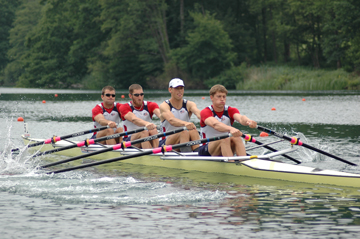
| TH E N I H C A T A L Y S T | S E P T E M B E R – O C T O B E R 2008 |
| | |
There is an Olympian amongst us. No, it's not Michael Gottesman. As many of you have heard by now, Gottesman fouled out of the final round of the U.S. Men's Basketball qualifying trials after a scuffle with Kobe Bryant over his relentless Hack-a-Shaq antics.
Jamie Schroeder, a member of the USRowing Senior National Team as well as the NHLBI Laboratory of Cardiac Energetics, competed in the Beijing Olympics, placing 5th in the Men's Quad Scull, a sprinting two-kilometer race in which the Polish team ultimately captured the gold. The 27-year-old Schroeder also competed in the 2004 Athens games as part of the Men's Four.
Schroeder is participating in the NIH Oxford/Cambridge Scholars Program, an accelerated training program in which science students undertake research projects at the NIH and at either Oxford University or Cambridge University. Schroeder is also pursuing combined Ph.D./M.D. training. He is within a year of completing his Ph.D. at Oxford, and he will be transitioning to medical school at Johns Hopkins School of Medicine.

At Oxford—in addition to being a victorious Oxford Blue in the annual, storied Boat Race between Oxford and Cambridge—Schroeder developed a real-time motion-correction device to control a two-photon excitation laser-scanning microscope. He is using this tool to overcome drifting motion, a major barrier to time-course imaging of living perfused tissue.
At the Laboratory of Cardiac Energetics, Schroeder will continue tweaking his microscope and testing it in vivo, with an emphasis on heart muscle cells. As proof of concept, he has imaged the exposed tibialis anterior muscle of anesthetized mice. His team could directly assess the sarcomere lengths and mitochondrial energy state of both slow- and fast-twitch muscle fibers in the same field, along with the regional capillary flow. He hopes this quantitative muscle model can examine the effects of various physiological perturbations and provide unique in vivo insight into factors that affect the oxidative capacity of heart and skeletal muscle.
The microscope can track perturbations at the cellular level and to some degree the subcellular level over an acute period of one to ten seconds, maintaining consistent resolution. Once perfected, this technique should be useful for drug and proteomic studies.
The vigorous scientific and physical training begs the question: Does Olympic-level rowing and earning a Ph.D. and M.D. constitute a triathlon?
Schroeder is part of the Physiology section of the Laboratory of Cardiac Energetics, led by Bob Balaban. The Oxford/Cambridge Scholars Program is coordinated by the NIH Graduate Partnerships Program. Refer to http://gpp.nih.gov and http://oxcam.gpp.nih.gov for more details.
[The editor would like to note that he himself came within 10 seconds of breaking the world record for the 100-meter dash.]